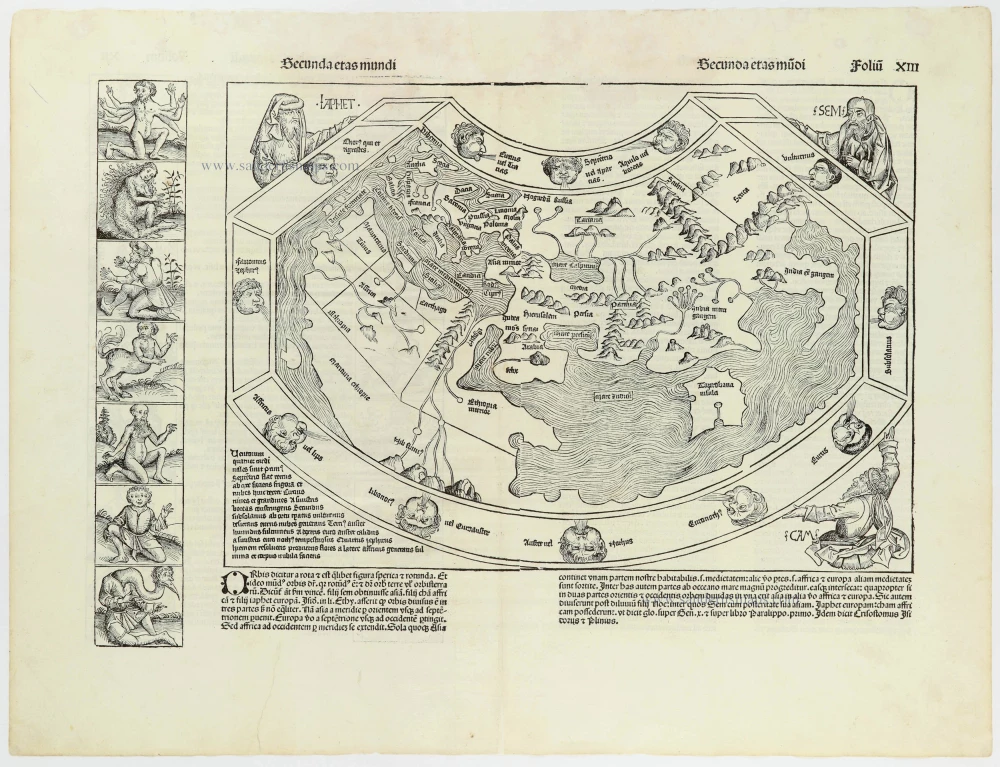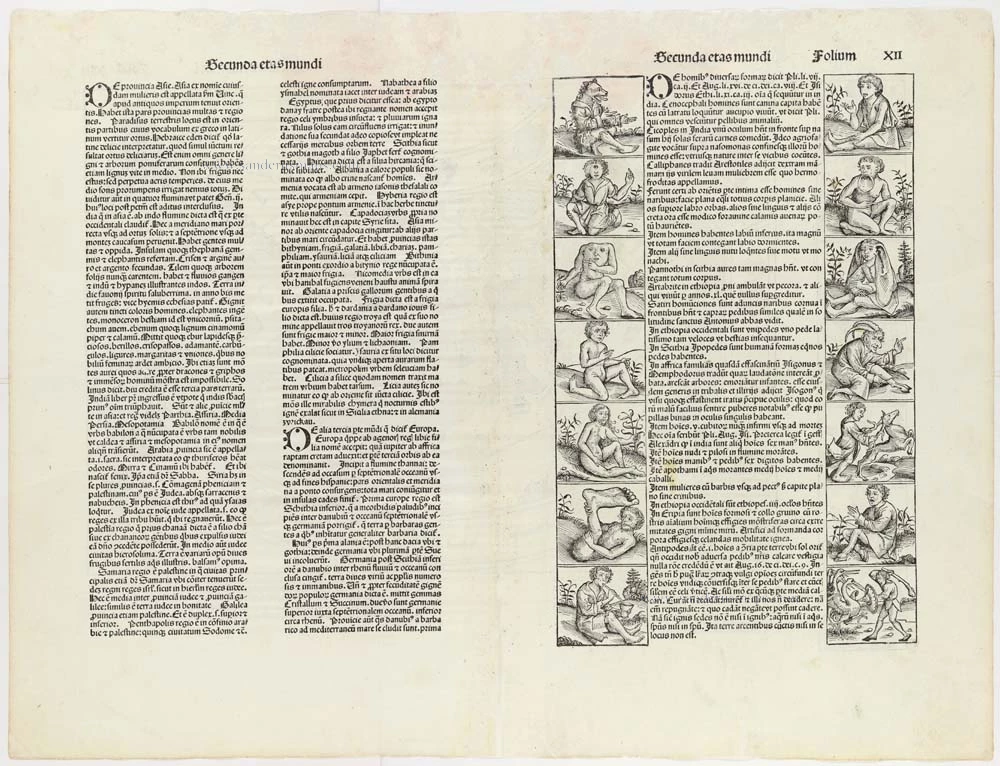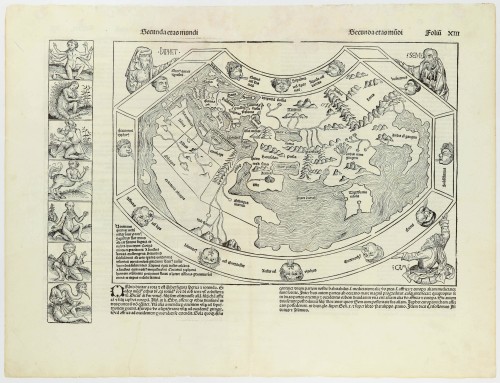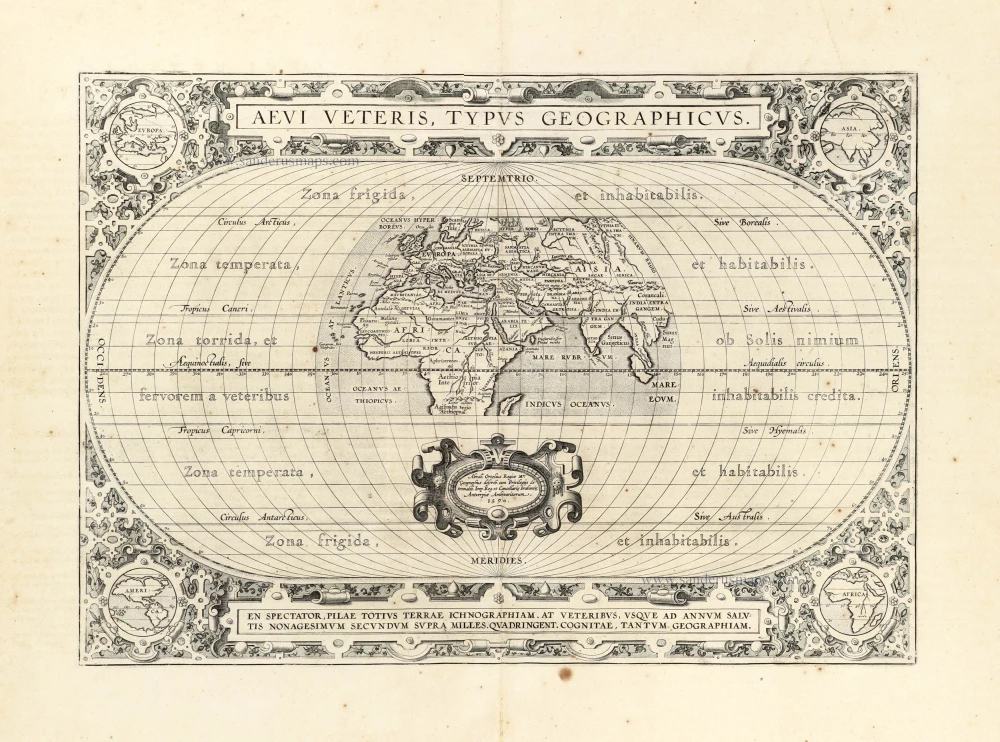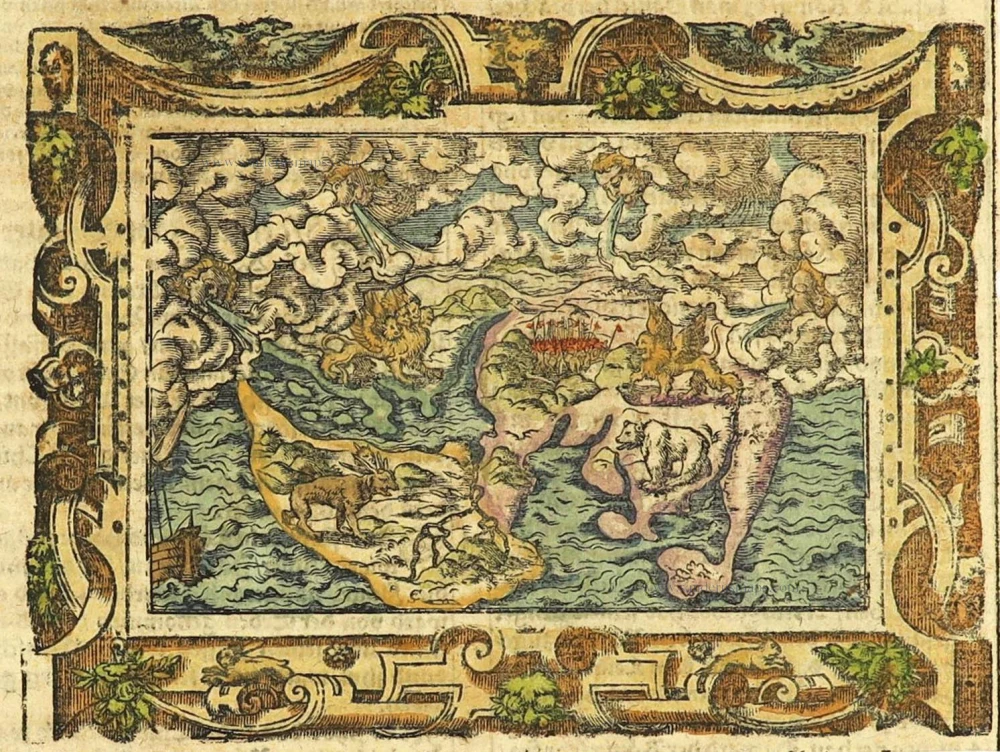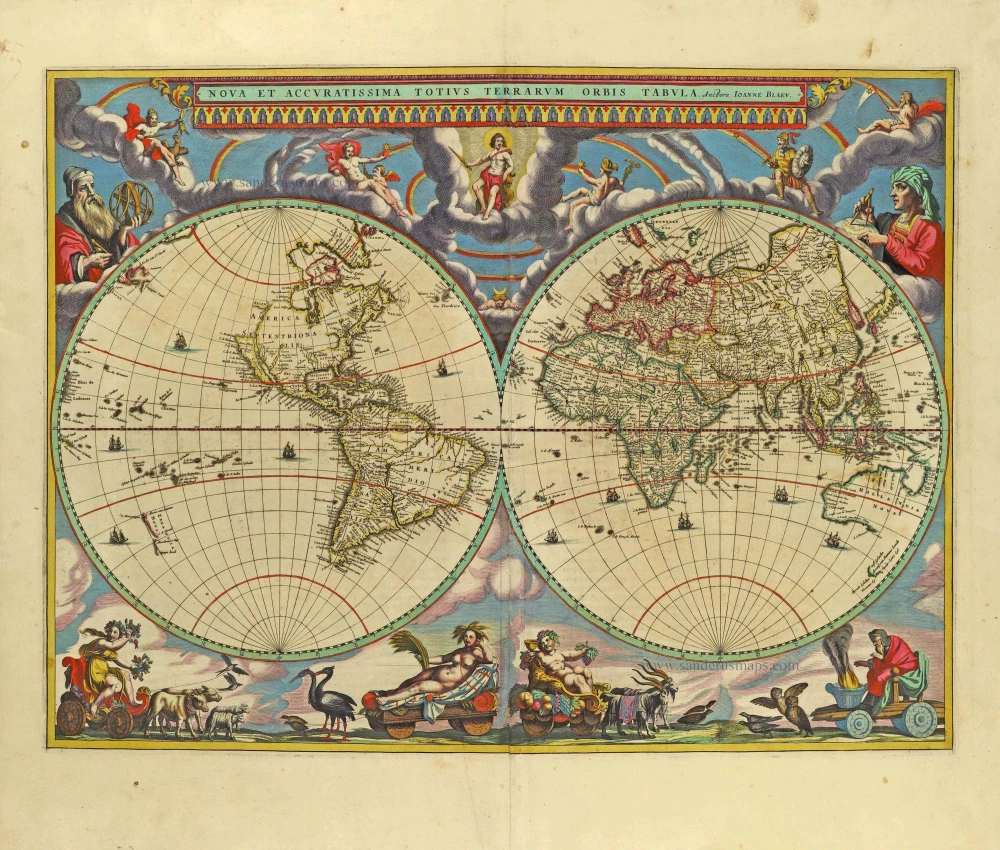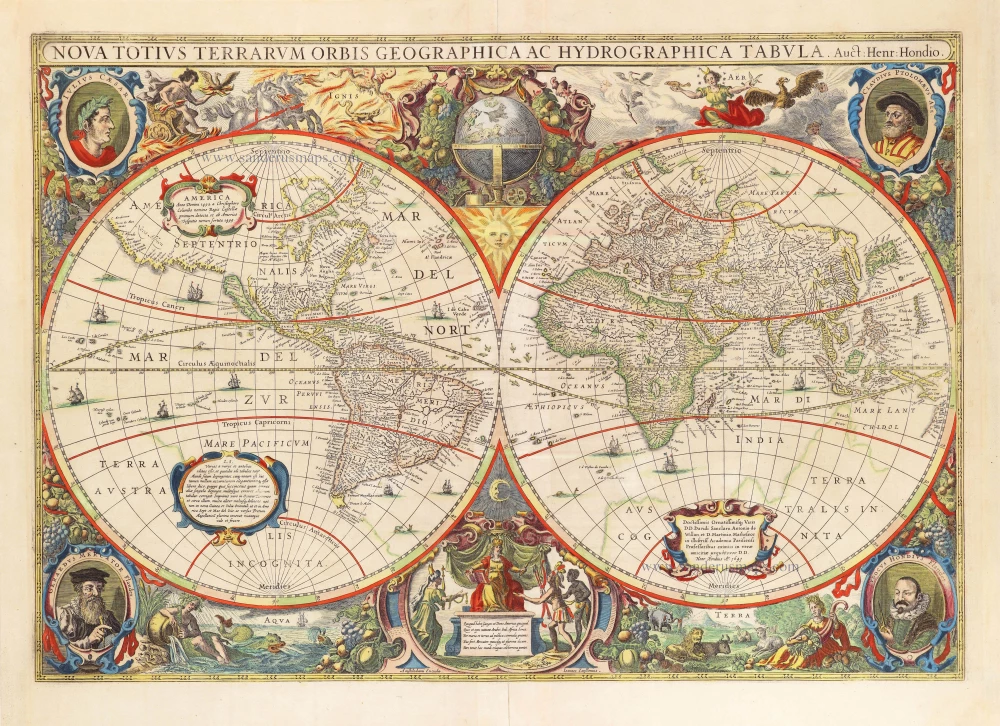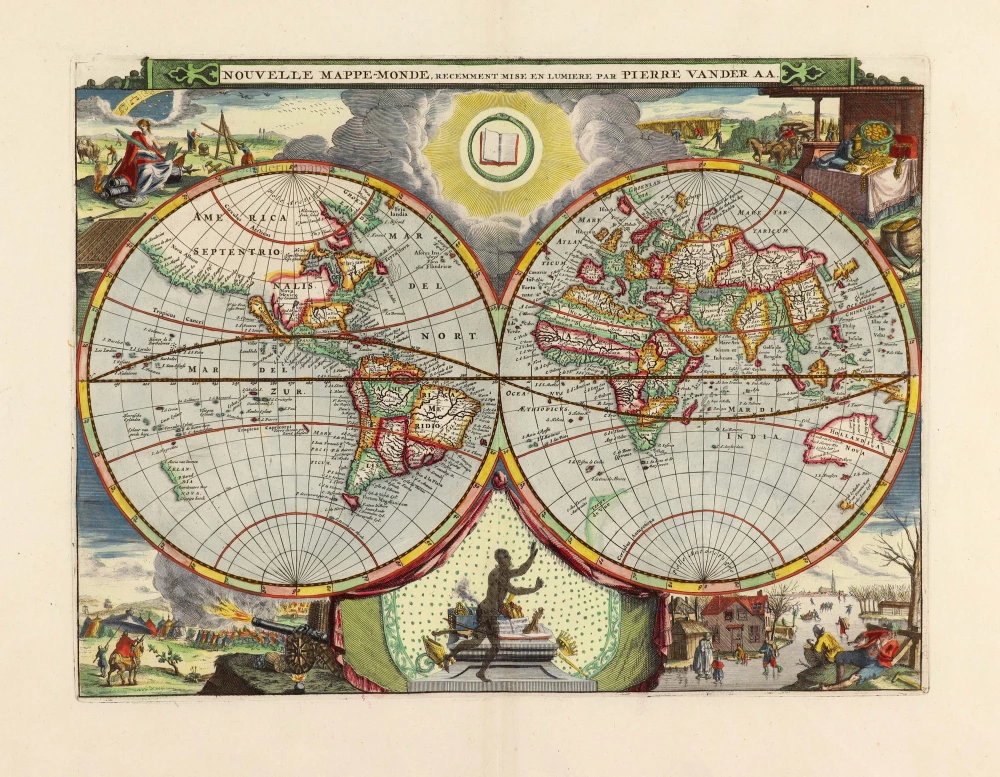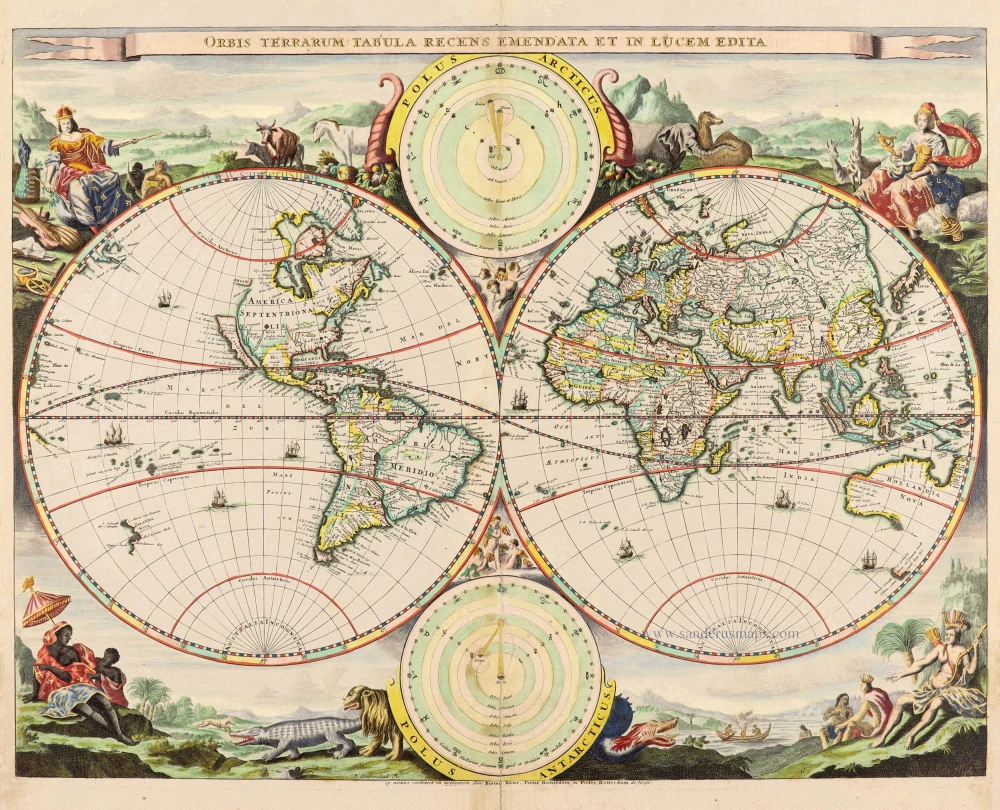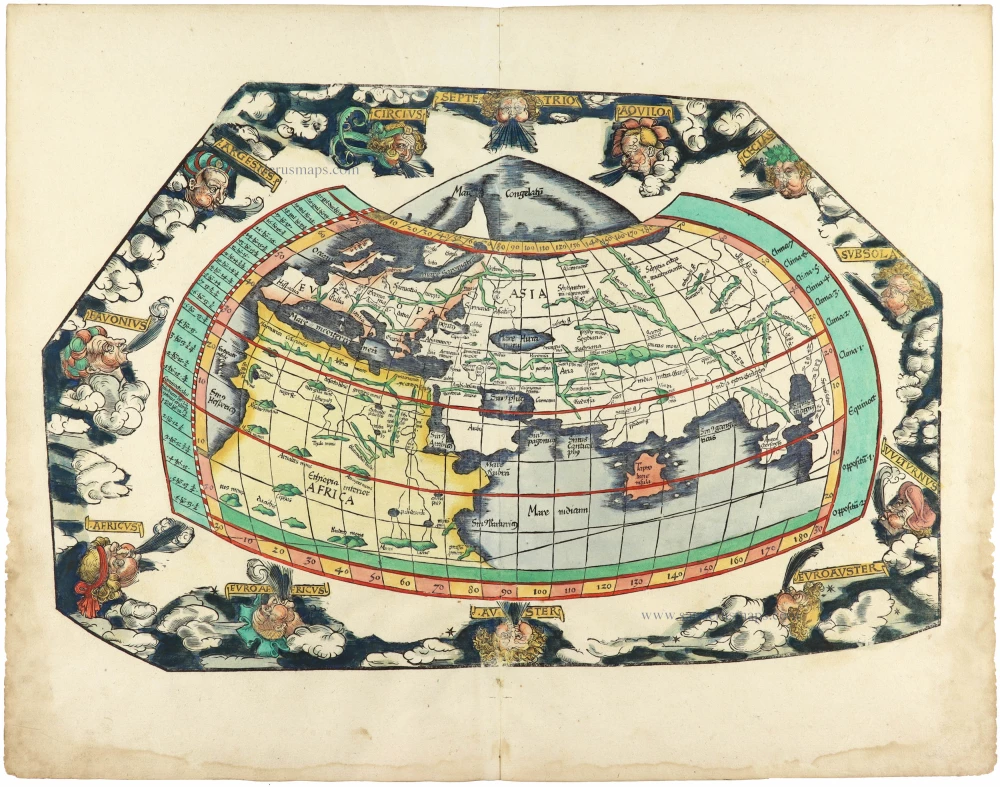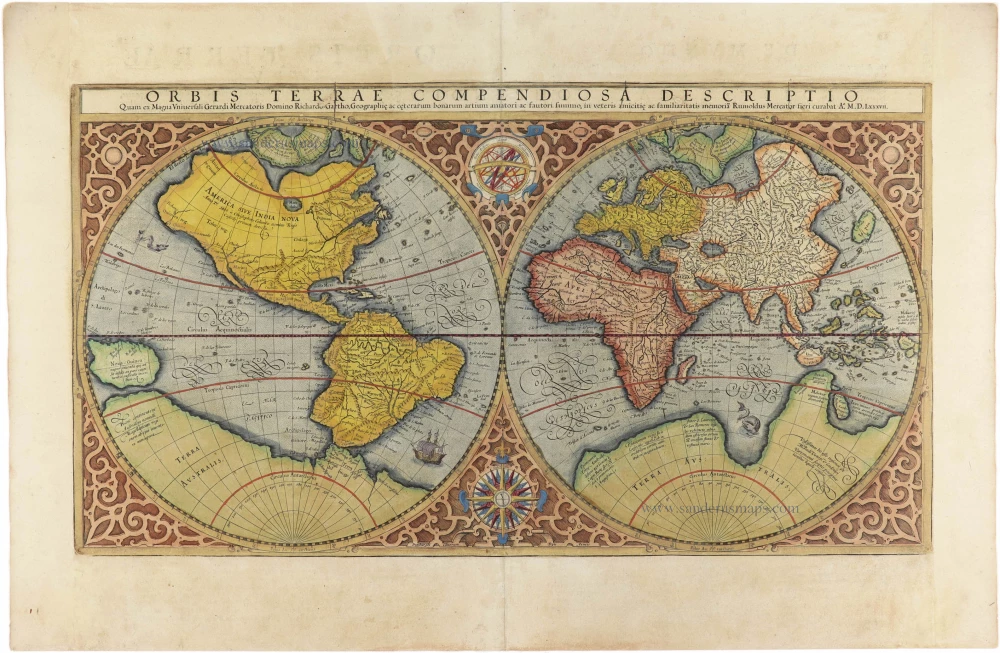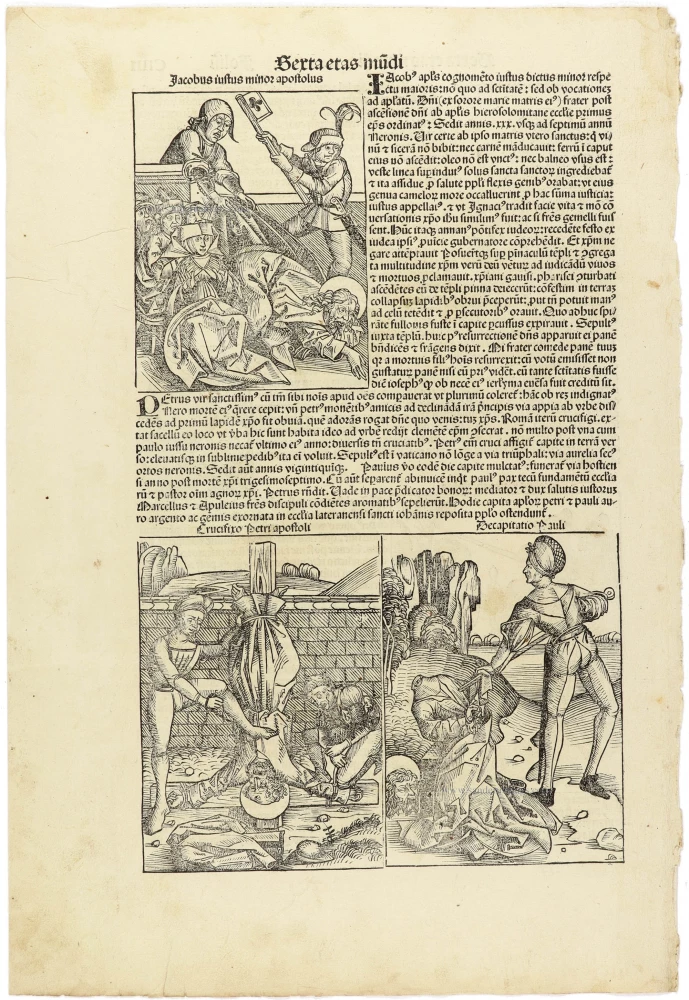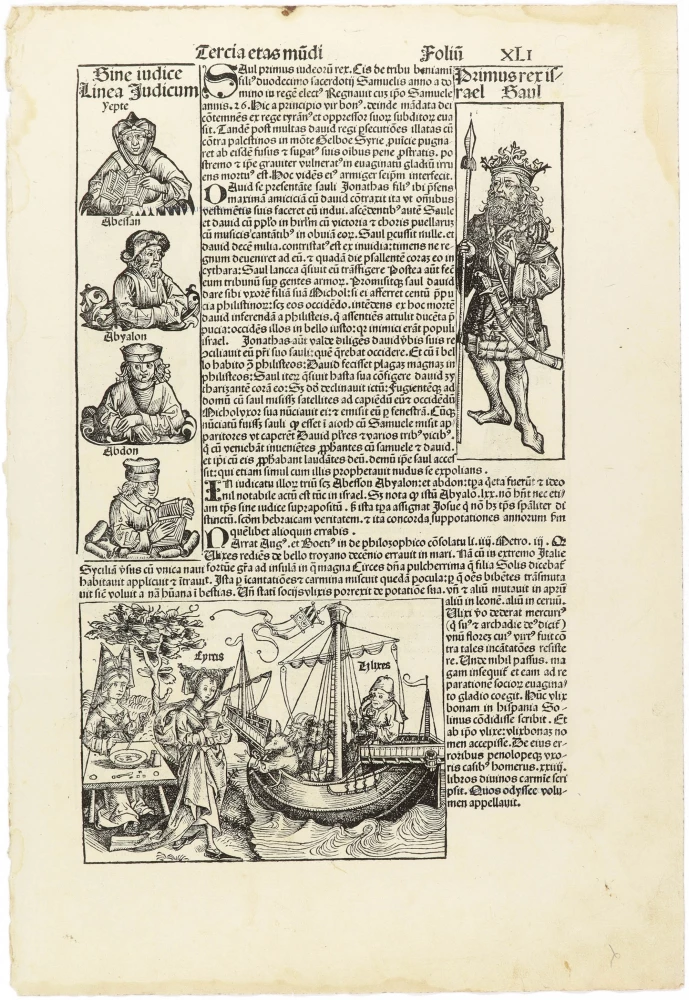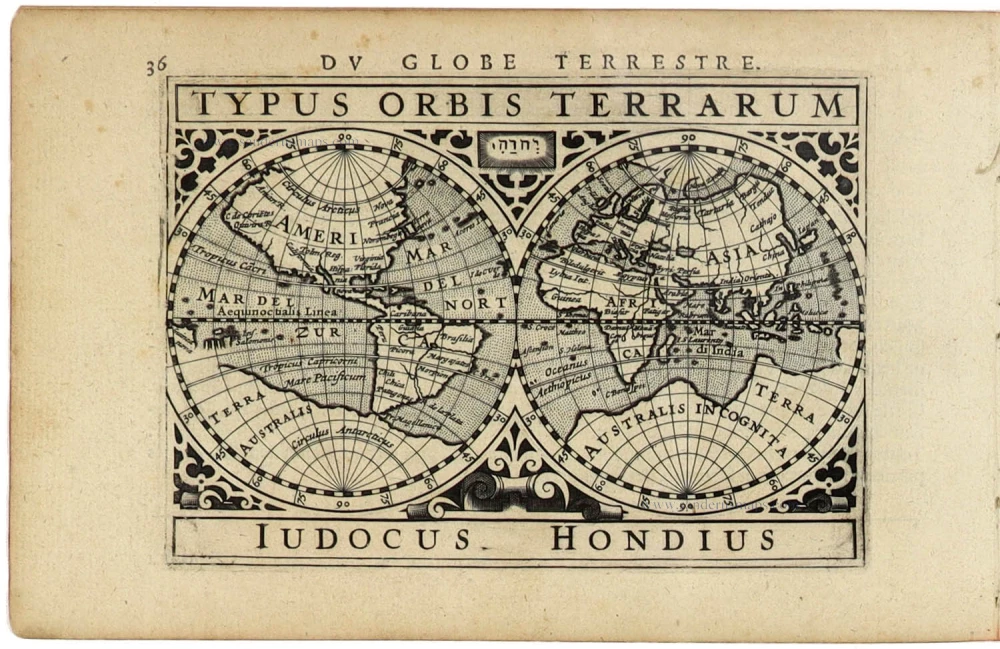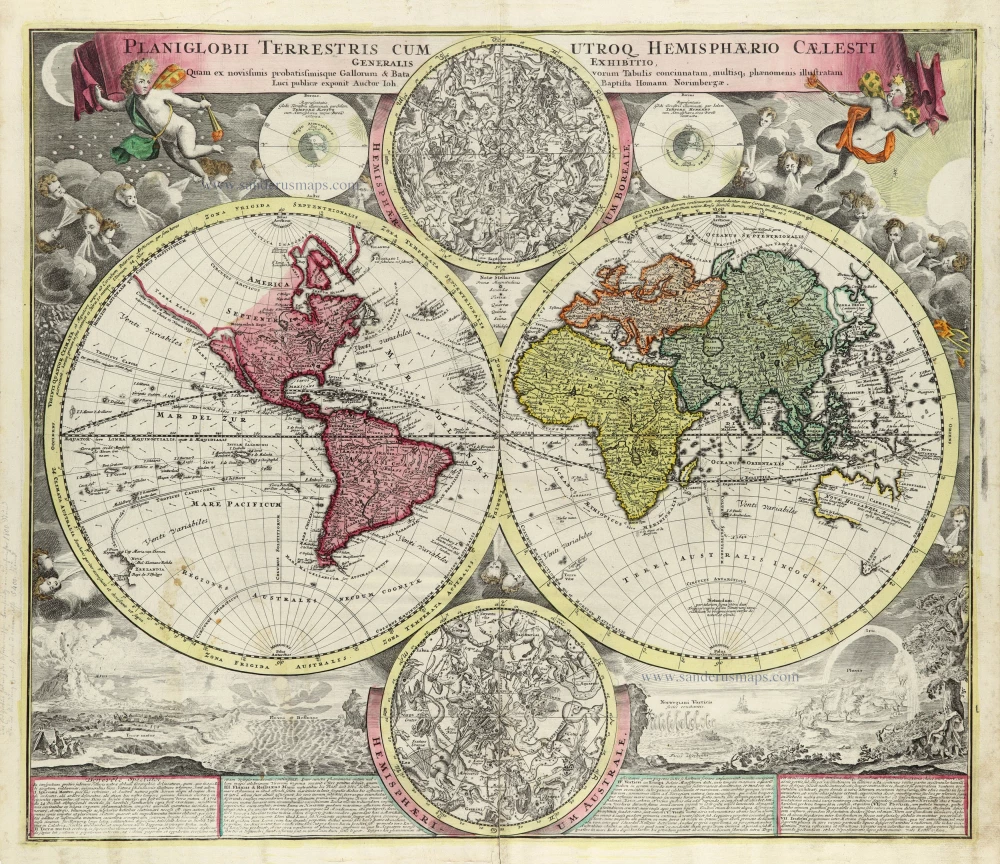The earliest obtainable and visually the most stunning world map
Ptolemaic World by Hartmann Schedel. 1493
This world map is a robust woodcut taken from Ptolemy. The border contains twelve dour wind heads, while the map is supported in three corners by the solemn figures of Ham, Shem, and Japhet taken from the Old Testament. The panels representing the outlandish creatures and beings thought to inhabit the farthest parts of the earth give the map its present-day interest and attraction. Seven such scenes are to the left of the map and fourteen on its reverse.
The map is a copy of a Venetian woodcut added to Pomponius Mela's Cosmographia eleven years previously. Like the Mela map, it references contemporary discoveries in its hint of the Gulf of Guinea, e reflecting Portuguese knowledge of about 1470. The unsigned Mela map was the first to show these developments in print. This Schedel derivative and the separately published world map of Francesco Rosselli were the only fifteenth-century printed maps to repeat these details. The current map adds one minor refinement: a curiously shaped, unidentified island off the West African coast.
Hartmann Schedel (Nuremberg, 1440-1514) and the Nuremberg Chronicle.
Hartmann Schedel grew up in Nuremberg and first studied liberal arts in Leipzig. He earned a doctorate in medicine in Padua in 1466, then settled in Nuremberg to practice medicine and collect books. According to an inventory done in 1498, Schedel's library contained 370 manuscripts and 670 printed books.
Schedel is best known for writing the text for the Nuremberg Chronicle, an illustrated biblical paraphrase and world history that follows the story of human history related in the Bible; it includes the histories of many important Western cities. The Nuremberg Chronicle was one of the most remarkable books of its time. It was commissioned by Sebald Schreyer (1446–1520) and Sebastian Kammermeister (1446–1503) and published in 1493 in Nuremberg. Maps in the Chronicle were the first-ever illustrations of many cities and countries. Wolgemut and Pleydenwurff, the painters, were commissioned to provide the illustrations and to take care of the layout. The large workshop of Michael Wolgemut, then Nuremberg's leading artist in various media, provided the 1,809 woodcut illustrations (including duplications).
Albrecht Dürer was an apprentice with Wolgemut from 1486 to 1489, so he may well have participated in designing some of the illustrations.
The Liber Chronicarum was first published in Latin on 12 July 1493 in the city of Nuremberg, printed by Anton Koberger, the most successful publisher in Germany. A German translation followed on 23 December 1493. An estimated 1,400 to 1,500 Latin and 700 to 1,000 German copies were published.
Due to the great success and prestige of the Chronicle, pirate editions soon appeared on the market. Johann Schönsperger (c. 1455-1521), a printer working out of Augsburg, published smaller editions of the Chronicle in 1496, 1497, and 1500 in German and Latin.
Claudius Ptolemy (c.100 – c.170 AD)
Claudius Ptolemaeus was a Greek astronomer, mathematician, and geographer who lived in Alexandria in the 2nd century. His ideas influenced much of medieval astronomy and geography. He was the first to use longitudinal and latitudinal coordinates. His idea of a global coordinate system was highly influential, and we use a similar system today.
Ptolemy wrote several scientific treatises. The first is the astronomical treatise, now known as the Almagest. The second is the Geography, which is a thorough discussion of the geographic knowledge of the Greco-Roman world. The third is the Apotelesmatika, an astrological treatise in which he attempted to adapt horoscopic astrology to the Aristotelian natural philosophy of his day.
The Geographia is a compilation of geographical coordinates of the part of the world known to the Roman Empire during his time. However, the maps in surviving manuscripts of Ptolemy's Geography only date from about 1300, after Maximus Planudes rediscovered the text. It seems likely that the topographical tables are cumulative texts that were altered and added to as new knowledge became available in the centuries after Ptolemy.
The earliest printed edition with engraved maps was produced in Bologna in 1477, followed quickly by a Roman edition in 1478. An edition printed at Ulm in 1482, including woodcut maps, was the first one published north of the Alps.
Secunda Etas Mundi.
Item Number: 30669 Authenticity Guarantee
Category: Antique maps > World and Polar
Ptolemaic World by Hartmann Schedel.
Title: Secunda Etas Mundi.
Date of the first edition: 1493.
Date of this map: 1493.
Woodcut, printed on paper.
Image size: 31 x 44mm (1.22 x 1.73 inches).
Sheet size: 475 x 630mm (18.7 x 24.8 inches).
Verso: Latin text.
Condition: A few small restorations in margins (outside the image), two wormholes filled. Nice copy with wide margins.
Condition Rating: A.
From: Liber Chronicarum. (= Nuremberg Chronicle). Nuremberg, Koberger, 1493.
This world map is a robust woodcut taken from Ptolemy. The border contains twelve dour wind heads, while the map is supported in three corners by the solemn figures of Ham, Shem, and Japhet taken from the Old Testament. The panels representing the outlandish creatures and beings thought to inhabit the farthest parts of the earth give the map its present-day interest and attraction. Seven such scenes are to the left of the map and fourteen on its reverse.
The map is a copy of a Venetian woodcut added to Pomponius Mela's Cosmographia eleven years previously. Like the Mela map, it references contemporary discoveries in its hint of the Gulf of Guinea, e reflecting Portuguese knowledge of about 1470. The unsigned Mela map was the first to show these developments in print. This Schedel derivative and the separately published world map of Francesco Rosselli were the only fifteenth-century printed maps to repeat these details. The current map adds one minor refinement: a curiously shaped, unidentified island off the West African coast.
Hartmann Schedel (Nuremberg, 1440-1514) and the Nuremberg Chronicle.
Hartmann Schedel grew up in Nuremberg and first studied liberal arts in Leipzig. He earned a doctorate in medicine in Padua in 1466, then settled in Nuremberg to practice medicine and collect books. According to an inventory done in 1498, Schedel's library contained 370 manuscripts and 670 printed books.
Schedel is best known for writing the text for the Nuremberg Chronicle, an illustrated biblical paraphrase and world history that follows the story of human history related in the Bible; it includes the histories of many important Western cities. The Nuremberg Chronicle was one of the most remarkable books of its time. It was commissioned by Sebald Schreyer (1446–1520) and Sebastian Kammermeister (1446–1503) and published in 1493 in Nuremberg. Maps in the Chronicle were the first-ever illustrations of many cities and countries. Wolgemut and Pleydenwurff, the painters, were commissioned to provide the illustrations and to take care of the layout. The large workshop of Michael Wolgemut, then Nuremberg's leading artist in various media, provided the 1,809 woodcut illustrations (including duplications).
Albrecht Dürer was an apprentice with Wolgemut from 1486 to 1489, so he may well have participated in designing some of the illustrations.
The Liber Chronicarum was first published in Latin on 12 July 1493 in the city of Nuremberg, printed by Anton Koberger, the most successful publisher in Germany. A German translation followed on 23 December 1493. An estimated 1,400 to 1,500 Latin and 700 to 1,000 German copies were published.
Due to the great success and prestige of the Chronicle, pirate editions soon appeared on the market. Johann Schönsperger (c. 1455-1521), a printer working out of Augsburg, published smaller editions of the Chronicle in 1496, 1497, and 1500 in German and Latin.
Claudius Ptolemy (c.100 – c.170 AD)
Claudius Ptolemaeus was a Greek astronomer, mathematician, and geographer who lived in Alexandria in the 2nd century. His ideas influenced much of medieval astronomy and geography. He was the first to use longitudinal and latitudinal coordinates. His idea of a global coordinate system was highly influential, and we use a similar system today.
Ptolemy wrote several scientific treatises. The first is the astronomical treatise, now known as the Almagest. The second is the Geography, which is a thorough discussion of the geographic knowledge of the Greco-Roman world. The third is the Apotelesmatika, an astrological treatise in which he attempted to adapt horoscopic astrology to the Aristotelian natural philosophy of his day.
The Geographia is a compilation of geographical coordinates of the part of the world known to the Roman Empire during his time. However, the maps in surviving manuscripts of Ptolemy's Geography only date from about 1300, after Maximus Planudes rediscovered the text. It seems likely that the topographical tables are cumulative texts that were altered and added to as new knowledge became available in the centuries after Ptolemy.
The earliest printed edition with engraved maps was produced in Bologna in 1477, followed quickly by a Roman edition in 1478. An edition printed at Ulm in 1482, including woodcut maps, was the first one published north of the Alps.

